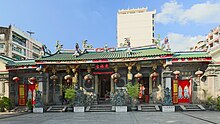

Chinese folk religion plays a dynamic role in the lives of the overseas Chinese who have settled in the countries of this geographic region, particularly Burmese Chinese, Singaporean Chinese, Malaysian Chinese, Thai Chinese, Indonesian Chinese and Hoa. Some Chinese Filipinos also still practice some Chinese traditional religions, besides Christianity of either Roman Catholicism or Protestantism, with which some have also varyingly syncretized traditional Chinese religious practices. Chinese folk religion, the ethnic religion of Han Chinese, "Shenism" was especially coined referring to its Southeast Asian expression; another Southeast Asian name for the religion is the Sanskrit expression Satya Dharma (literally "Truth Law").
The Chinese folk religion of Southeast Asia is markedly typified by the interaction with Malay indigenous religions (Malaysian and Indonesian folk religion), the adoption of gods of Hindu derivation, such as Brahma, Ganesha and Hanuman, and also syncretism with Christianity in the Philippines. The philosophical forms of Confucianism and Taoism are followed, and organised forms of the Chinese folk faith, such as the Church of Virtue, Yiguandao and Zhenkongism, have taken significant foothold among Southeast Asian Chinese.
In Singapore about 11% of the total population is Taoist, including the 14.4% of Chinese Singaporeans identifying as Taoists.[1] In Malaysia, around 10% of Chinese Malaysians practice Chinese folk religions, corresponding to around 1% of the country's population.[2] However, numbers may be significantly larger since many folk religious Chinese register as "Buddhists" for census purposes. In Indonesia, Taosu Agung Kusumo, leader of the Majelis Agama Tao Indonesia, claims there are 5 million Taoist followers in the country as of 2009.[3]
- ^ Singapore Department of Statistics (12 January 2011). "Census of population 2010: Statistical Release 1 on Demographic Characteristics, Education, Language and Religion" (PDF). Archived from the original (PDF) on 3 March 2011. Retrieved 16 January 2011.
- ^ "2010 Population and Housing Census of Malaysia" (PDF). Department of Statistics, Malaysia. Archived from the original (PDF) on 13 November 2013. Retrieved 17 June 2012. p. 13
- ^ "Tao, Taoism Religion". Indonesiamatters.com. Retrieved 20 November 2011.
